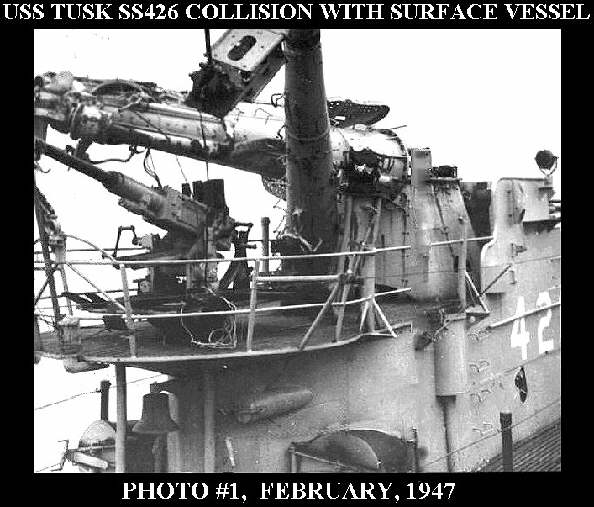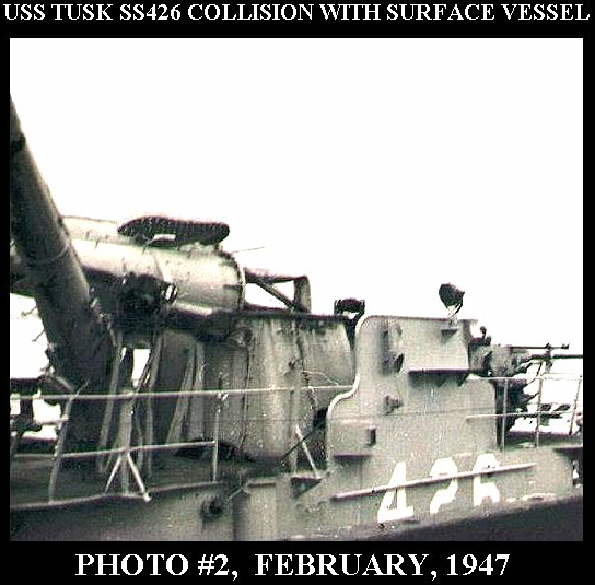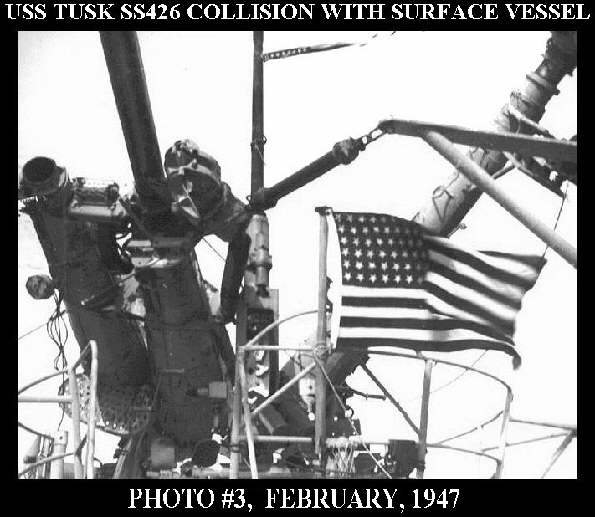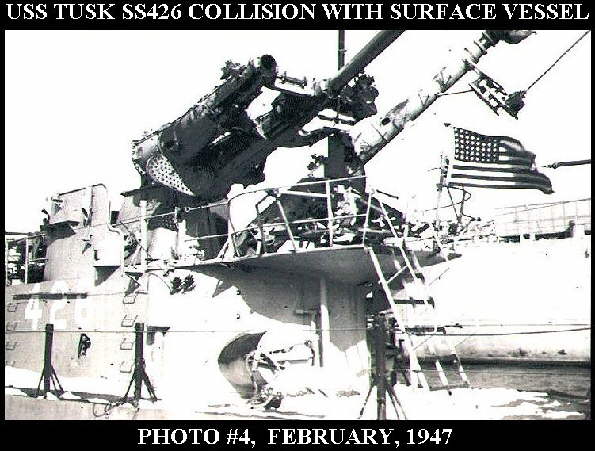    |
||
|
|
||
Click on photo to enlarge
During my cruise we were doing maneuvers in the Atlantic near the African coast and collided with the Hospital Ship Consolation while coming up to periscope depth, 60 feet. We suffered extensive damage and could not submerge. Consequently, we had to travel on the surface through a hurricane back to home port in Philadelphia. where the Tusk was repaired and retrofitted to the Guppy class.
Richard Gottardi RM3/C (46-48)
In the Month of February my boat was stationed in the mid-Atlantic Ocean preparing for battle maneuvers. We were going to simulate an attack on a convoy that included Naval Warships forming a large protective circle around a group of Aircraft Carriers, Battleships, Cruisers, Tankers, Oilers and the Hospital Ship Consolation. The plan was to break through the circle of warships, select a suitable target and then fire an 'air slug' instead of a real torpedo. At that moment I would send the letter "S" in Morse Code repeatedly on our sonar transmitter and that signal would be picked up by surface vessels. Personnel on my boat and the surface vessels would note their exact position and time upon hearing my signal. When the exercise was over, the position, time and coordinates of the involved vessels plus the torpedo speed and angle would be correlated to determine if our hypothetical torpedo would have successfully struck its target.
During this attack I sat at the Sonar Equipment Station in the Conning Tower and listened to sounds made by surface ships, recording their location, speed and distance from our vessel. The Captain's plan was to dive to a level of one hundred feet, cruise under the outer protective ring of Destroyers and then attack the most valuable ship in the center of the convoy. I was sitting at my position, watching and listening as the Captain followed his plan. Upon reaching the desired location we stopped our motors and began listening. After a small period of time the Destroyers' sonar 'pinging' (a method of transmitting sound pulses through the water and listening for them to bounce back after striking a submarine and revealing its location and speed) and the noise from the surface ships' screws appeared to stop. As I found out later, the convoy had detected our presence and all the surface vessels shut down their engines and became "dead in the water" to enhance the Destroyers ability to better detect our presence and location with their sonar equipment. This tactic also forced our boat to be "blind," so to speak, and consequently lose the location of our targets and other "enemy" vessels. I reported this phenomena to the Captain and after some deliberation he ordered the boat up to periscope depth to survey the area. "Take her up to 60 feet," (periscope depth) he shouted. I could hear the compressed air hissing into ballast tanks as the boat acquired additional positive buoyancy and began to rise.
The Diving Planes Operator applied a slight turn to his large Control Wheel and the boat began a 5 degree up angle toward the surface. I was sitting on a small, pull-out stool in front of the Sonar Gear, straining to hear anything that might give us a clue as to what was happening on the surface. The turning screws of our own vessel began to drown out any other signals I might have heard. Six or seven crew members were in the conning tower during that maneuver. There was no hint of impending disaster, just the hum of machinery and the mix of crewmen's voices. As our boat continued to rise, the Captain ordered "Up Periscope." It began rising from the deck and just as it reached its proper position, the collision occurred.
BAM! BOOM! RATTLE! The force of the collision shook and rattled the entire submarine. It immediately rolled 45-to-55 degrees to the starboard. I slid off my stool and landed in several inches of water. That's right, water, already. Everyone had that puzzled look on their face. There was absolute silence. It was as if we were in a movie and suddenly the projector jammed and we were part of a still picture. Seconds went by with nobody moving. The boat then righted itself and once again smashed against the surface vessel's hull. Then suddenly, as if the projector was restarted, everyone moved, started talking and shouting commands. Me, I was sitting on the wet deck watching water spraying from our radar console (radar signals from the antenna travel through "wave guides" instead of wires and these guides resemble small ducts having a square cross section of about 3-4 inches) and drenching every one of us with sea water. The external pressure was forcing water into the outside broken wave guide, then into the Conning Tower and out through the small openings in the console.
I suddenly recalled my training in Submarine School stating that if we ever collided with a surface vessel I should grasp the wrench that is clipped to the overhead near the wave guide and use it to turn a nut that would close it off, much like the metal shutter in a fireplace chimney or in the flue of a stove. Now that I look back, I often wonder how-in-the-hell I remembered to do that in what appeared to be a life-and-death situation with my adrenaline nearly blinding me. As soon as I turned the nut, the water spouting from the radar console quit. But that didn't stop the flooding. The hull of the Conning Tower had cracked and a thin sheet of water aft of the radar console was being forced Page 5 through the crack and across the width of the room, contributing to the depth of sea water at our feet.
I remember looking down and watching water flow over the deck hatch side guards and into the Diving Compartment below. I unconsciously started to move toward the hatch with the intention of climbing down and escaping what looked like a possible drowning situation. At that moment the Captain shouted, "Ring the collision alarm." Training had taught us to close the hatches to all compartments upon hearing that alarm. And so, as I was moving toward the deck hatch to escape, I watched a pair of hands emerge from below, grab the hatch cover and close it. There goes my escape plan!
Now the next bit of horror was starting to enter our minds. Since all crew members are taught to handle each other jobs or positions, most of the crew knew there was a blind spot above the boat where the sonar was useless. The sonar detecting equipment was on the keel, underneath the mass of the boat. Consequently, the boat itself blocked any sound above it from being picked up. And so none of us knew if the colliding vessel's screws were turning. That meant at any moment the large blades of turning screws could slice right through the Conning Tower and chop it to pieces, crew included. We knew that if we attempted to surface, we could die a horrible death or at least once again collide with whatever vessel was above us. Following this reasoning, the Captain got on the intercom to the Diving Officer below and shouted , "Take her down to 100 feet!" "No, No," he replied, "Let's surface, let's take her up!" "Listen," shouted the Captain, "Take her down to 100 feet or I'll have your ass if and when we reach shore!" Well, I guess that threat was enough to convince the Diving Officer to follow the Captain's orders. And so down we went, water still surging inside the Conning Tower and rising up to our ankles, especially now that the deck hatch to the Diving Compartment below was sealed and the water had nowhere to drain.
Leaks from the collision had caused sea water to enter the Radio Shack and short out the amplifiers controlling the boat's main intercom system. The system between the Conning Tower and Diving Compartment had separate amplifiers and worked fine, but the rest of the crew had no way of knowing what was going on because of the failed main amplifiers. These men, seeing that we were going down and unaware of the extent of the damage, were beginning to express the terror they felt, visualizing their eminent death.. Each crew member pictured his boat sinking below crush depth, the bulkheads collapsing from the increased pressure and their bodies squashed to jelly while falling several thousand feet to the ocean bottom.
The men in the forward and aft Torpedo Compartments had bathometers (depth gauges) and when they saw the needle dropping to a lower and lower depth they began to pray and express the terror they felt. Meanwhile those of us in the Conning Tower and Diving Compartment had full awareness of the situation and although fearful, maintained a reasonable amount of confidence in our survival. We continued sinking deeper into the Atlantic, keeping our blood-drained fingers crossed, hoping that unknown damage would not incapacitate our ability to stop sinking or prevent our rising to the surface. Since we were unable to view the outside of the boat and see the extent of our damage, the possibility existed that other sections had been damaged or flooded without our knowledge. Since the intercom was disabled and individual compartments could not report any problems to the Captain, we had to assume that the Conning Tower took the brunt of the collision and that no other compartments suffered damage -- you can be sure that doubts concerning additional and unreported damage were on our mind, and on the minds of those sailors isolated in their separate compartments throughout the boat. We all breathed an audible sigh of relief when we leveled out and stopped at the one hundred foot level.
Now you have to once again imagine those crew members in the aft and forward torpedo rooms spending what seemed an eternity watching their gauges, thinking that their boat had been fatally disabled and consequently anticipating the end of their lives. And imagine again the relief they felt when those needles stopped falling and held steady at one hundred feet. It had been a test of their courage and fortitude.
After reaching the hundred-foot depth, a flare gun was fired. A small tube installed in the bulkhead of the Diving Compartment penetrated to the outside and was capped at both ends. The inside cap was removed, the flare inserted, the inside cap closed and the outside cap opened to the sea. A trigger mechanism similar to a pistol was activated and the flare shot out to the sea, rising to the surface and up into the sky alerting all surface vessels to stay at least 1000 yards clear of the its location. After waiting approximately thirty minutes, the Captain, speaking for all of us, shouted to the Diving Officer, "Blow all ballast, take her up!' There were no protests or complaints from the Diving Officer that time! As soon as the boat angled upward you could see the smiles and expressions of relief on everyone's face, including mine. And it didn't take too much effort to imagine the relief felt by the rest of the crew scattered throughout the boat as they felt it tilt upward and watched their depth gauge needles move upward. It had been a harrowing experience. We stood there in silence, each thanking whatever gods may be for our survival.
At last the boat broke surface and settled in the water. As was the custom, the crewman nearest the conning tower hatch would scamper up the short ladder and open the hatch and then come back down, allowing the Captain to be the first to occupy the quarterdeck. Well, as it happened, I was nearest the hatch when the Captain ordered it opened. I climbed up swiftly, turned the wheel, cracked the hatch and then retreated. The Captain then climbed the ladder, pushed the hatch wide open, took a quick look around and muttered, "Oh, my God." Myself and other crewmen climbed the ladder right after the Captain, sucked in the cool, clean air, almost knelt in gratitude for our survival and then stood in shock while surveying the damage surrounding us.
Both periscopes and their shears (protective covers) were now horizontal, bent down 90 degrees from the vertical, as were the radar and radio masts. Bolts two inches thick had been snapped off and were scattered around the quarterdeck along with pieces and shards of iron and steel. The whole area had been flattened by what must have been a very large and heavy surface vessel.
Well, it wasn't long before the Captain ordered me to the Radio Shack to contact a nearby Destroyer on the emergency frequency. It was all I could do to get it together and once again accept my responsibility in a calm and efficient manner. The hour or so of adrenaline pumping had exhausted my body and mind, and I had to make a conscious effort to muster enough strength to follow orders.
I entered the Radio Shack and moaned over what I saw. The radio antenna overhead mount had cracked from the force of the collision and sea water had doused the transmitter, the intercom amplifiers and other related equipment. Page 8 Upon inspection, water had penetrated each level of the transmitter hardware and made it completely useless. Fortunately, a portable transmitter unit was dry and available and I carried it up to the quarterdeck, informing the Captain that the portable unit was the only operable transmitter. With that he ordered me to contact a nearby Destroyer. Once accomplished, he requested the Destroyer to escort us back to Base until and if we could get our normal communication gear working.
The next few days were spent in dismantling the larger and more powerful transmitter, drying all the parts, testing individual circuits and finally putting it back into working condition. We then ran a test and successfully communicated with a shore station on the mainland. The escorting Destroyer was informed of our success and consequently left to rejoin the convoy. We could now establish radio contact with east coast shore stations and inform Naval Headquarters of our status and anticipated return to home port in Philadelphia. You would think that now the USS Tusk had survived a crucial test of its endurance and could look forward to a peaceful and healing trip back to the States.
It was not meant to be. Since our Conning Tower was damaged and various equipment seals had been breached, we could not risk submerging, no matter the circumstances. And I tell you, one big circumstance appeared a day after losing our Destroyer escort. And that circumstance was called a Hurricane! For those of you that have attempted to sail through a Hurricane, I don't have to describe the nightmare ahead. The waves appeared to be fifty feet high or more. And the worst part was that the hurricane was traveling in the same direction as ourselves at approximately the same speed!. Normally, any submarine can dive to about a hundred feet and the water would be calm while a hurricane would be raging on the surface. But as I said, we couldn't submerge and had to withstand the fearsome pummeling of one great, big, awful hurricane while riding on the surface like a long, thin, round toothpick, pitching and rolling at the whim of a fearsome sea and howling gales.
Now since our radar was disabled, myself and other crewmen were enlisted to perform lookout duty, manning the quarterdeck with binoculars day and night and suffering under incessant rainfall and sea spray. The boat would ride atop a huge wave, lose stability and consequently yaw off course with the helmsman Page 9 having to constantly correct. Then the wave would pass and the entire submarine would be left partly in mid air, dropping quickly and shuddering with shock when reaching the bottom of the valley between each wave. Before we could rise above the oncoming wave we would plow right through its center, a wall of water cascading over the entire boat and quarterdeck. We were wearing sealed rain gear from head to foot, and as the oncoming wave was about to strike we would grasp the rail in front of us, lock our arms around it, lower our heads and feel the onrushing water trying to carry us away. During these onslaughts of towering waves one crewman lost his grip, was swept aft, and saved his own life by hooking the back of his knee, the crook of his leg, around a vertical stanchion while the rest of us rushed to pull his dangling body back on deck.
We had to ride this hurricane for a total of five days. As you can imagine, not only did the boat violently pitch up and down, but continued to roll left and right up to forty and fifty degrees. It was impossible for the cook to create meals and so mealtimes consisted of sandwiches only, stacked in cardboard boxes lashed to mess tables. We would reach into the boxes, grab a sandwich, wrap our arms around any nearby pipe, or equipment and try to eat while the boat would rock back and forth. First you would be looking up at the opposite bulkhead and then be looking down. Sleeping meant strapping yourself tightly into your cot so you wouldn't roll off and hit the deck. People who thought themselves immune to seasickness were vomiting all over the place. I remember watching the helmsman turn green, puking and falling to the deck. I had to take over for him. And these were the conditions that seventy-five men had to endure until reaching port. Although I never threw up, I had that sick feeling to my stomach for the whole period, being right on the edge of violent seasickness.
Now here's the irony. We finally pulled into Philadelphia after dark, covered with sheets of ice, a ghostly apparition returning after a narrow escape from Davey Jones' locker. That night the entire crew was able to sleep comfortably alongside the pier. And what did I do? In the middle of the night I suddenly awoke, ran to the head and upchucked. Speculation is that my stomach got used to the constant rolling and pitching motion over a five-day period and became confused when it had to re-adapt to a quiet, level environment.
After each of us had an opportunity to rest and catch up with our lives, we had to undergo a Naval Investigation and describe in our own words what happened before, during and after the collision. Consequently the Captain was transferred. It was then Navy policy that Submarine Captains were only allowed one mistake and would be automatically transferred to shore duty, never to command a submarine again.
As for myself, well, I survived and continued through my enlistment period without any permanent scars. It was an experience that I will never forget. It brought me close to death and encouraged me to appreciate life. I have always been very grateful for all the experience and training the Navy provided. It literally made a man of me, taught me to accept responsibility and started me off to a rewarding and successful career. I loved the Navy, always have and always will. Anchors Aweigh!